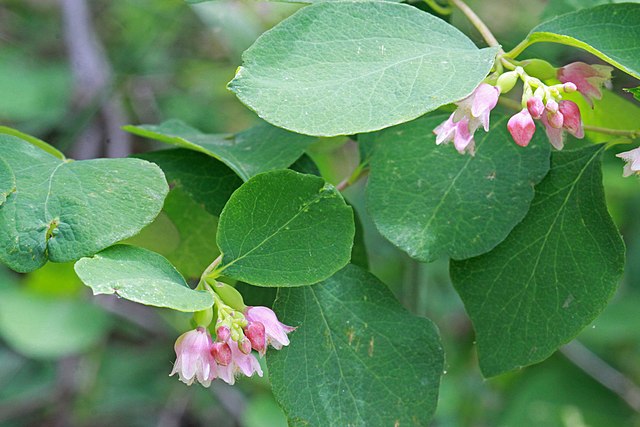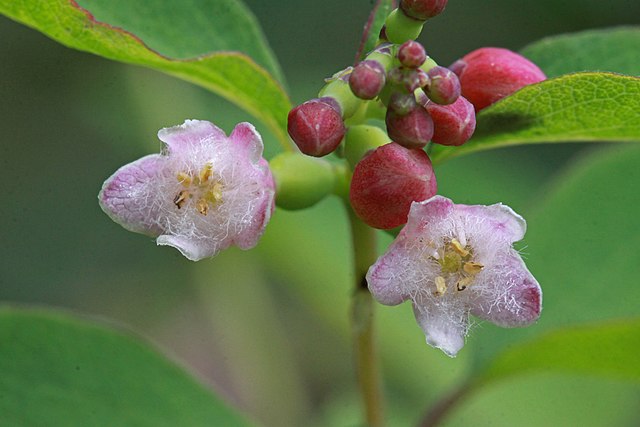
Featured Photo by Matt Lavin / CC BY-SA 2.0
A field guide on how to identify and propagate Western Snowberry (Symphoricarpos occidentalis), a hardy shrub that is native to western North America.
How to Identify Western Snowberry (Symphoricarpos occidentalis)
Leaves

The leaves of Western Snowberry are elliptical, approximately 1 to 2 inches long, with smooth margins and arranged oppositely on the stem.
Fruit

The fruit of Western Snowberry consists of small, round berries, typically pink or white in color, and about 0.25 to 0.5 inches in diameter.
Flower

The flowers of Western Snowberry are small, tubular, and bell-shaped, typically pink or white in color.
Flowering Season
Western Snowberry typically flowers in late spring to early summer, around May to June.
Habitat
Western Snowberry is commonly found in open forests, wooded slopes, and meadows across western North America, ranging from coastal areas to mountainous regions.
Some other understory plants that associate with Western Snowberry are:
- Forest Grasses
- Mountain Laurel (Kalmia latifolia)
- Wild Rose (Rosa acicularis)
Wildlife Value
Western Snowberry plays a crucial role in supporting local wildlife ecosystems. The berries produced by this shrub are a significant food source for various bird species, including robins, thrushes, and waxwings. These berries are particularly important during the winter months when other food sources may be scarce.
In addition to being a valuable food resource, Western Snowberry provides shelter and nesting sites for several bird species. Its dense and twiggy structure offers protection for small mammals, birds, and insects. The shrub’s presence contributes to the overall biodiversity of its habitat.
The flowers of Western Snowberry attract pollinators such as bees and butterflies, supporting the broader ecosystem. As a hardy and adaptable species, it enhances the resilience of local plant communities and contributes to the stability of the surrounding environment.
Overall, Western Snowberry’s ecological contributions make it a valuable component of native landscapes, promoting biodiversity and providing ecological services to the wildlife that depends on it.
How to Propagate Western Snowberry (Symphoricarpos occidentalis)

Hardiness Zone: 2-7

Soil Type: Well-drained, loamy soil

Water: Normal to low

Exposure: Full Sun to Partial Shade
You can propagate Western Snowberry with two effective methods:
- Stem Cuttings: Propagation by cutting is successful with this plant, particularly in late spring or early summer.
- By Seed: Propagation by seed is also viable, especially when sown in late fall or early winter under cold stratification conditions.
How to Propagate Western Snowberry (Symphoricarpos occidentalis) by Seed
How to Harvest Seeds
Harvest the seeds when they are mature and have a whitish color, indicating maturity.
Next, you must mash the fruit, sieve the mixture, dry them, and finally winnow to separate the seed from the chaff.
If you cannot harvest seeds yourself, you can always order them online at Prairie Seed Shop in Canada.
Stratification
Western Snowberry seeds benefit from stratification. Place them in a plastic bag with a moistened substrate (e.g., peat moss) and refrigerate for 6 weeks.
Sowing
Sow the seeds in well-draining soil and keep them consistently moist until germination, which typically takes 2-4 weeks.
How to Propagate Western Snowberry (Symphoricarpos occidentalis) by Cuttings
To propagate Western Snowberry through stem cuttings, follow these steps:
- Timing: Choose a healthy parent plant, and take cuttings in late spring or early summer when the plant is actively growing.
- Cutting Selection: Select semi-hardwood cuttings with a length of 4-6 inches, ensuring they have at least two nodes.
- Preparation: Remove the lower leaves, leaving only a couple of leaves at the top. Optionally, apply a rooting hormone to enhance rooting.
- Planting: Insert the cuttings into a well-draining rooting medium, such as a mix of perlite and peat moss.
- Environment: Place the cuttings in a shaded area with indirect light. Keep the soil consistently moist but not waterlogged.
- Rooting Time: Roots should develop in about 4-6 weeks. You can gently tug on the cutting to check for resistance, indicating root formation.
- Transplanting: Once rooted, transplant the cuttings into individual pots with potting soil. Allow them to establish before transplanting into the garden.
FAQ
Here are some frequently asked questions about Western Snowberry:
A: While it’s possible, the recommended time for propagation is late spring or early summer for stem cuttings and late fall or early winter for seed sowing.
A: Germination typically takes 2-4 weeks under optimal conditions.
A: While not mandatory, using a rooting hormone can enhance the success rate of rooting.
